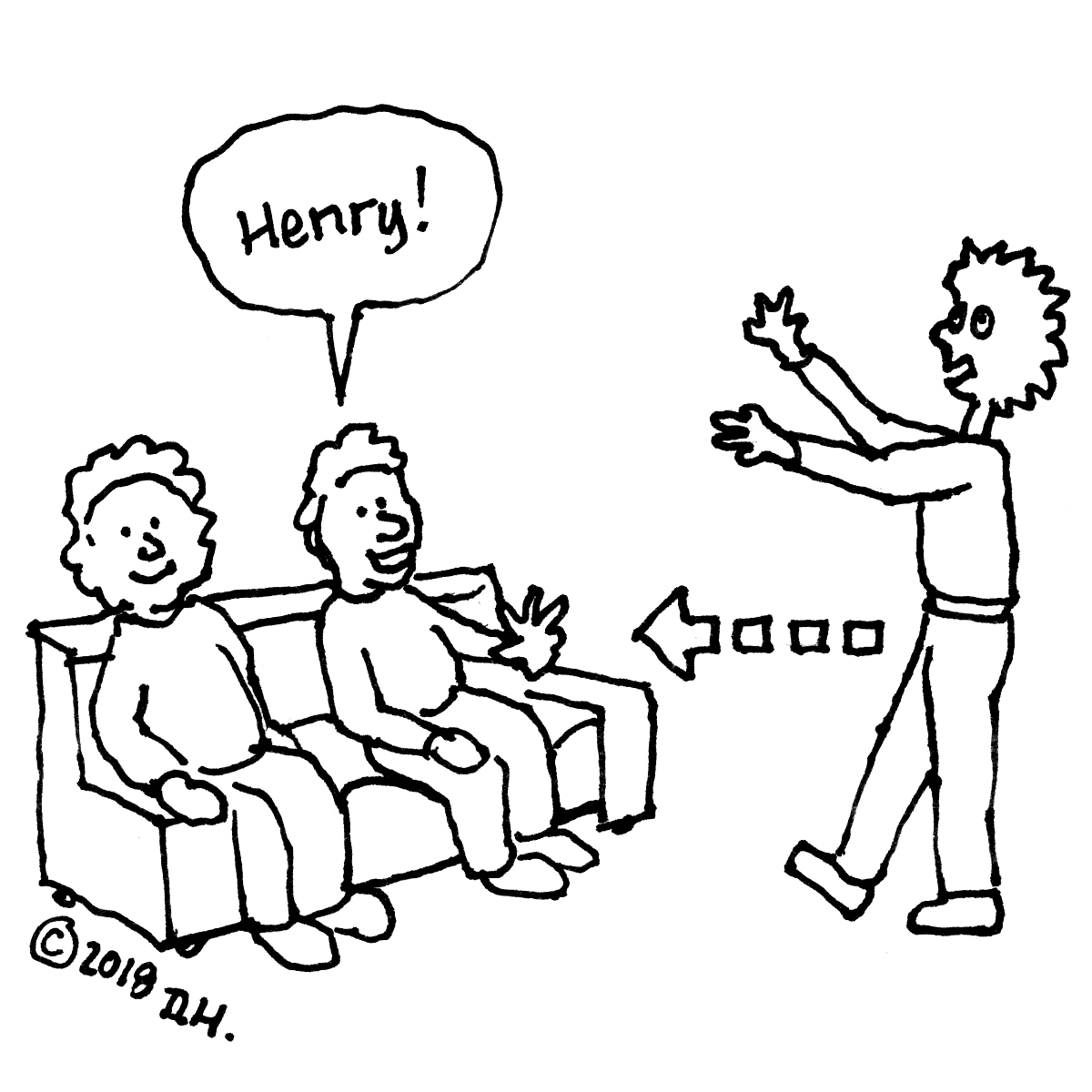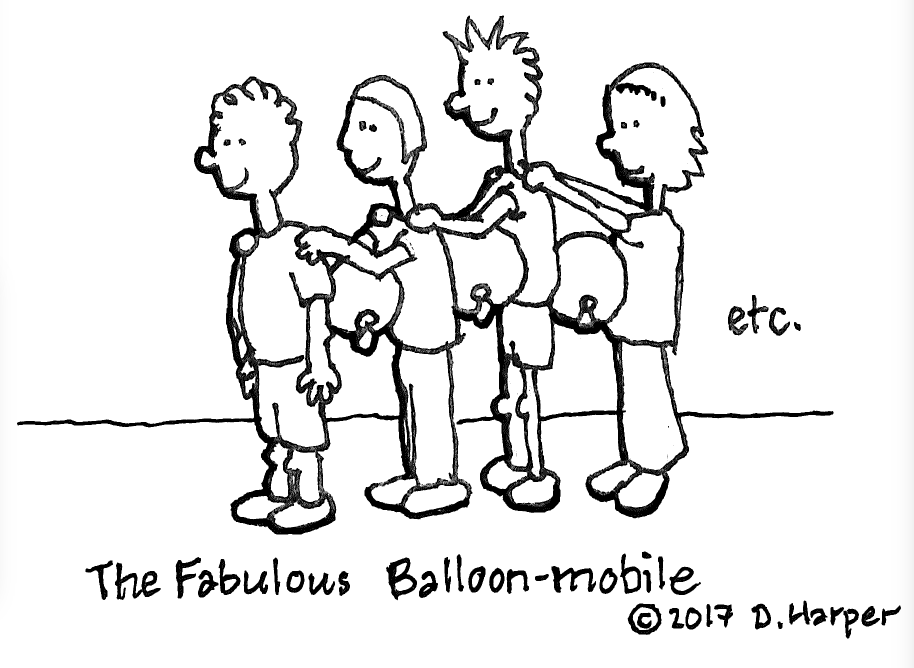Games for UU kids and adults
Compiled by Dan Harper
Copyright © 2014-2021 Dan Harper (except where noted otherwise)
Animal Name Game
Grocery Store Game
Name Game song
Name Gesture Game
Roll-the-Ball
Who Stole the Cookies from the Cookie Jar?
Zombie Name Game
The Balloon-mobile
Defender
Don’t Touch Me
Friends and Neighbors
I’m Going To Blank and I’m Taking a Blank
Knots Game
Ocean Wave
Pattern Ball
Zip Zap Zoop
Games in each section are listed with games suitable for younger kids first, then increasing in age.
Note that for younger children, “Duck, Duck, Goose” works well as an icebreaker game!
Name Games
Roll-the-ball Name Game (ages 3-10)
For youngest kids (pre-K): Get a big soft ball (beach ball, big nerf ball, what-have-you). Everyone sits in a circle. One of the adults says the name of a child, and rolls the ball to them. Now the child rolls the ball back to the adult, and says their own name as they roll it. Continue until the adult has rolled to ball to every child.
For older kids (K and up): Get a big soft ball (beach ball, big nerf ball, what-have-you). Everyone sits in a circle. One person says that name of another person, and rolls the ball to them. That person then says the name of a third person and rolls the ball to them. And so on around the circle, until everyone has had a chance to say their name.
The name game song (ages pre-K and up)
The Name Game was a pop song from 1964. You can sing the chorus as a name game. First, how to sing the song:
For most names, you sing it like this, with the person’s name repeated at the end of every line minus to first consonant:
Sally, Sally, bo-bally,
Banana fana fo-fally,
Fee fi mo-mally,
Sally!
However, if the name starts with a “b” (like “Buffy”), or an “f” sound (like “Fabian” or “Phyllis”), or an “m” sound (like “Maria”), then you drop the first consonant of the name on the end of the line with the same first consonant, like this:
Buffy, Buffy, bo-UFFY,
Banana fana fo-fuffy,
Fee fi mo-muffy,
Buffy!
Maria, Maria, bo-baria,
Banana fanna fo-foria,
Fee fi mo-aria,
Maria!
AND if the name begins with a vowel sound, you obviously don’t take off the first letter of the person’s name, like this:
Allie, Allie, bo-bally,
Banana fanna fo-fally,
Fee fi mo mally,
Allie!
That’s the song. (For younger kids, you don’t have to explain all these rules, just sing the song and they’ll imitate you.) Here’s how to play:
Sit in a circle. One by one, each person says their name (or an adults says it for shyer ones), and then the group sings the song with that name.
Guitarists: The chords are really easy.
(starting note: C)
[C] Sally, Sally, bo-bally,
Banana fana fo-fally,
[F] Fee fi mo-mally,
[C] Sally!
Zombie Name Game (ages 5 and up)
Sit in a big circle. One person is the Zombie. The Zombie shuffles in a typical Zombie fashion, with arms outstretched, and with a sloooow shuffling gait (Zombies cannot shuffle too fast, or they will fall apart).
The Zombie begins shuffling towards one person (Zombies have to move in a straight line). The person towards whom the Zombie is shuffling must call out the name of another person, and then the Zombie must shuffle towards that person. If the Zombie reaches a person before they can call out another person’s name, then that person becomes the Zombie.
Younger children may need help and coaching from adults on at least two points — walking slooowly (Zombies can’t run!), and remembering the names of other children.

Animal Names (ages 8 and up, variation for ages 5 and up)
Sit in a circle. Each person comes up with an animal that has the same first sound, or the same first letter, as their own name, e.g., “I’m Dan the Dog” AND add a motion that goes with it, so Dan-the-Dog pants and holds up two hands like paws.
The next person says “Dan-the-Dog” and makes the dog motion, then adds their own name: “I’m Greg Giraffe,” and sticks their arm up like a long neck.
The next person says “Dan-the-Dog” and makes the dog motion, “Greg-the-Giraffe” and puts their arm up like a long neck, then adds their own name: “I’m Ella-Elephant,” and makes an elephant trunk out of their arm.
And so on around the circle. It’s OK to help people remember the name and animal by making the appropriate motion.
The last person may feel put upon — so the adult who started the game off should go all the way around the circle with names at the end. And you should also end by saying, “Is there anyone with a really good memory who’d like to try to say all the names?”
Variation for ages 5 and up: Even though younger children tend to have excellent memories, they may freeze up playing with the above rules. So you might want to play this game as follows: First person says their animal name — everyone repeats it back. Second person says their animal name — then everyone says the FIRST person’s name, then the second person’s name. Third person says their animal name — then everyone says the FIRST person’s animal name, then the second person’s animal name, then the third person’s animal name. And so on.
Name Gesture Game (age 6 to adult)
Have everyone stand up in a circle. Go around the circle and have each person say their name with an adjective in front (e.g. “Sleepy Greg”). Now add a gesture or pantomime along with the adjective (i.e., “Sleepy Greg” might pretend to close his eyes and snore). After everyone has said their name with an adjective, go around the circle once more with everyone repeating their name and adjective.
Next choose someone to start, and have them point to another person in the circle and say the name of the person being pointed at, along with their associated name and gesture. The person they were pointing at, then takes the next turn, by pointing to someone else in the circle and saying the name of the person they are pointing at, along with the associated name and gesture. Keep going until hopefully everyone has had one or two turns.
Game rules copyright (c) 2018 Greg Becker. Used by permission. Thanks, Greg!
Who Stole the Cookies from the Cookie Jar? (ages 6 and up)
First, you have to learn the chant, which goes like this (syllables that fall on the beat are in italics):
[group] Who stole the cookies from the cookie jar?
[Leader] Ed stole the cookies from the cookie jar!
[Ed] Who, me? [clap, clap]
[group] Yes, you! [clap, clap]
[Ed] Couldn’t be! [clap, clap]
[group] Then who? [clap, clap]
[Ed] Annie stole the cookies from the cookie jar!
Everyone does the claps. They help keep the group in rhythm.
The hard version, for older kids: Once you’ve learned the basic chant, go around the circle and everyone says their name. Now you’re ready to play. In the example above, the leader starts things off by naming Ed. Ed names Annie. Next Annie chants the lines that Ed had been chanting, and she will say someone else’s name to pass things along to that person. Each person in turn goes, naming someone who hasn’t yet been named, until there’s no one left but the leader who started the whole thing off. The leader can end the game by chanting, “No one stole the cookies from the cookie jar?” or by naming another person, in which case you play another round.
The easy version, for younger kids: The leader is always the one who chants the line, “(Name) stole the cookies from the cookie jar!”
Grocery Store Game (age 8-adult)
Here’s how I play this game:
“Pick an item that you can buy in the grocery store,” I’ll say, “the name of which begins with the same letter or the same sound as your name. So I’m Dan Dogfood.”
We go around the circle and players chose grocery store names for themselves: Sara Saran Wrap, Zach Zucchini, Melissa Marshmallow, Dori Doughnut, and so on.
“Now one person stands in the middle of the circle with a pillow,” I say, demonstrating what I mean, “and one person, let’s say Oliver Olives, starts us off by saying ‘I like…’ and then someone’s grocery store name. So for example, Oliver might say, ‘I like Bill Berries.’
At this point, I will try to tap Bill Berries with the pillow before he can name someone else.” Which causes Bill Berries to say hurriedly, “Ari Asparagus,” who in turn says, “Heather Hair Spray,” who doesn’t respond before I tap her with the pillow, so she goes into the center of the circle to start the next round.
Variation
Instead of using a pillow, make a “swat” by rolling up some newspaper, or a piece of flip chart paper, into a tube that’s an inch or two in diameter and three or four feet long.
Icebreaker Games
The Balloon-mobile (ages 6 to adult)
Preparation: Blow up twice as many balloons as people you’ll have in your group. Big (8-12 in. dia.) round balloons work best. (If you want to blow them up ahead of time, you can store blown-up balloons in a plastic garbage bag, or in a clean trash bin.)
Tell the participants that they’re going to get a ride in the Fabulous Balloon-mobile! The Balloon-mobile is a kind of car that can carry everyone in the group, and it’s so much fun to ride in you won’t believe it! There’s just one important thing to remember — the Fabulous Balloon-mobile WILL NOT WORK if it is missing any balloons.
In order to create the Balloon-mobile, have the participants form a line. Now have each person putting their hands on the shoulders of the person in front of them (except the first person in line, of course). Next go down the line, and gently place one balloon in between every two people in line, like this:

Now tell the group that their goal is to get from one side of the room to the other. But remember! — if a balloon falls and hits the ground, the Fabulous Balloon-mobile will not longer work, which means they have to stop moving.
OK, so what do you do when a balloon hits the ground? There are several different options:
a. Easy, and for younger children: As soon as the balloon hits the ground, you say: “STOP!” then you replace the balloon for them, and once the balloon is back in place they can start moving again.
b. Moderate: The people on either side of the balloon that dropped go to the beginning of the line, everyone works to replace the balloons, then you start again.
c. More challenging: Same as b., except the whole group has to start at the beginning again.
d. Most challenging and most fun: The group has to figure out a way to pick up the dropped balloon (without dropping any more balloons of course!), replace, and get moving again.
Optional additional rule: The Fabulous Balloon-mobile has to go over an easy obstacle course (e.g., weaving around traffic cones or other objects; stepping over a knee-high barrier; going up a step or steps; etc.)
Optional alternative rule: The people who make up the Fabulous Balloon-mobile CANNOT touch each other. That is, people touch balloons, but people don’t touch people. This is alternative rule provides some additional challenge.
Don’t Touch Me (ages 6 to adult)
Have the group form a circle. Use a a bicycle tire inner tube, a hula hoop, a rope, or something to make an Inner Circle inside the circle of people. This inner circle should be about 26-36 inches in diameter.
Then divide the group into pairs, based on who is standing opposite each other in the circle. Make sure everyone knows who they are paired with. (If there are an odd number of participants, you can have a three-way pair, but you should not participate — you’ll see why in a minute.)
Tell the group that each pair is going to change places. As they change places, each person must place one foot inside the Inner Circle. And no one is allowed to touch any other person.
Ready to start the game? You say, “On the count of three, repeat after me, Don’t touch me.” Then the group says, “WE ARE READY!” And you say, “Ah-One! Ah-Two! Ah-Three!” Upon which everyone says, “DON’T TOUCH ME!” If you do this right, it will come out as a rhythmic chant:
On the count of three
repeat after me
don’t touch me.
[WE ARE READY]
Ah-One!
Ah-Two!
Ah-Three!
[DON’T TOUCH ME]
After this chant, as soon as you are ready to change places with the other person in your pair, you catch their eye and say, “DON’T TOUCH ME!” and as soon as they respond in turn by saying, “DON’T TOUCH ME!” you exchanges places with them. If two or more pairs exchange places at the same time, that’s fine, just make sure no one touches anyone else.
You can play this game again with different pairs.
Variation
Optional additional challenge: Try to exchange places with the other person in your pair as quickly as possible. And you’re going to time them. Remind them of the rules:
- In order to exchange places, you must first catch the other person’s eye and say, “DON’T TOUCH ME!”
- When you trade places, you must place one foot inside the Inner Circle.
- You must not touch anyone else (if two people touch, add 2 seconds to their total elapsed time).
OK, now tell them that they can do it faster. Remind them of the rules again. And see if someone figures out how to make this go really fast (you should be able to do it in five seconds or so, even with big groups).
Ocean Wave (age 7 and up)
Set up a circle of chairs, with one less chair than there are players. One player is in the center of the circle. The player in the center calls out: “Shift right!” or “Shift left!” All the other players have to shift to the right or left without allowing the player in the center to take their seats. Whoever allows their seat to be taken goes in the center next.
Defender (ages 7 and up)
In this game, people try to defend an individual they have chosen from an imagined attacker.
Everyone in the group spreads out through the playing space. Everyone picks another person in the room to be the “attacker” and a different person in the room to be the “victim”. This is done (in their head) without telling anybody else who they have chosen as their designated “victim” and “attacker.
When the leader says “Go!”, each person must continuously place himself or herself directly in between the “attacker” they have chosen and the “victim” they have chosen, therefore defending them at all times.
As people move to place themselves in-between their chosen “victim” and “attacker”, other people will have to adjust their positions to do the same thing.
The game ends when the leader says “Stop!”
Game rules copyright (c) 2018 Greg Becker. Used by permission. Thanks, Greg!
Zip Zap Zoop (ages 7 to adult)
(N.B.: There are many variations on this game. Before you start playing, make sure that everyone is playing by the same rules!)
Everyone sits in a circle. Now explain the basic moves of the game:
To Zip, you can use your right to point to your left, or your left hand to point to your right (one way to remember this is that you always point across your body), while saying “Zip!”

To Zap, you hold up your right hand to stop a Zip coming from your left, or vice versa (one way to remember this is that you always hold up your hand across your body), while saying “Zap!”

And to Zoop, you touch the top of your head like this:

…and then point to someone across the circle while saying “Zoop.”

Now here’s what to do with these moves:
Zip: If someone Zips you, you can pass the Zip in the same direction to the next person. The Zip is the most basic move, so you should practice this by having everyone send a Zip all the way around the circle.
Zap: If someone Zips you, you can send the Zip back in the other direction with a Zap. To deomnstrate this, ask one of the people next to you to Zip you, then Zap them, and coach them to now send the Zip in the opposite direction. Note that you can only Zap a Zip (you cannot Zap a Zoop, you cannot Zap a Zap).
Zoop: If someone Zips you, or if someone Zaps your Zip, you can send the play across the circle using Zoop. Whomever you point to when you Zoop must then Zip to one of the people on either side of them — or they may Zoop someone else in the circle (but they may not send the Zoop right back to you).
If someone does one of the moves wrong (e.g., if you use your right hand to point right on a Zip, if you say “Zip” when you are Zapping, if you try to Zap a Zoop, etc.), then everyone who notices the error is supposed to make a sound like one of those buzzers they have on TV game shows when someone gets an answer wrong: “Ehnnnnn!” Then play starts over with whoever made the last correct move.
Optional Funky Chicken Rule: When an error is made, the person who makes the error has to do the Funky Chicken, i.e., has to make some sort of chicken-like activity ranging from saying “Buc, buc” in a listless voice, to doing a whole-hearted chicken dance with thumbs tucked in armpits to make wings, wings flapping madly, making chicken sounds, and dancing. (Some people will make errors on purpose just so they get to do the Funky Chicken.)
Knots Game (ages 7 to adult)
You probably already know the basic rules:
Ask the participants to stand in a circle. Ask everyone to take their right hand and reach across the circle to grasp someone else’s right hand. Now ask everyone to reach across the circle again, this time with their left hand, and ask everyone to grasp the left hand of someone different (i.e., not the person whose right hand they are grasping). Now you are in a big tangled know. Without letting go of hands, ask the group to untangle the knot.
Note that the largest number you can include in this game is around 12-14 people. With more than a dozen people, you can’t really reach across the circle to grasp someone’s hand. The smallest number of people that the game is worth playing is 5-6; five participants is actually too small, but it could work for younger kids.
Now to deflate a myth about this game, and talk a little about math:
Some people will tell you that this game can always be untangled into a circle of people. That is obviously false. In my years of playing this game, I have seen the following when the knot is finally untangled:
- A single, simple circle
- A circle with an overhand knot in it
- Two linked circles
- Two unlinked circles
- Three linked circles
Those are just the untanglements I have actually seen; many more non-simple untanglements are possible.
What we’re really dealing with are one or more circles which are embedded in certain ways in three-dimensional Euclidean space. These circles can be described using mathematical knot theory; see more about mathematical knots on Wikipedia. However, if you’re trying to determine the maximum number of solutions, note that human arms have limits in the number of times they can cross, so thus limiting the number of solutions (I’d guess that the practical limit is on the order of two times the number of participants in the game). It’s also worth noting that the reason it is difficult to “untangle” the knot is because humans have inflexible appendages like legs and heads that get in the way of smoothly laying out the circles.
I’m Going To Blank and I’m Taking a Blank (ages 8 to adult)
Have everyone stand in a circle (or sit down in a circle if people are tired). Have a person start by saying “I am going to BLANK and I am bringing BLANK,” where they fill in the blanks. For example, “I am going to THE PLANET MARS and I am bringing MY FAVORITE PAIR OF SNEAKERS.”
The next person in the circle repeats what the previous person said and then adds on another item of their choice. For example, “I am going to THE PLANET MARS and I am bringing MY FAVORITE PAIR OF SNEAKER, and A YELLOW UMBRELLA.“
People keep going around the circle adding things to the list, until it seems like a good time to stop (try to make it at least twice around the circle). People in the circle should help the people reciting the list remember what the items are by giving non-verbal hints (i.e pantomiming using an umbrella).
Game rules copyright (c) 2018 Greg Becker. Used by permission. Thanks, Greg!
Pattern Ball Game (ages 9 to adult)
Have all everyone stand up in a circle. Have one person start by pointing at someone in the circle while saying “ONE” and putting their hand on their head. The person who was pointed at takes the next turn, by pointing at someone else in the circle who does not have their hand on their head, and says “TWO.” Keep going until everyone has their hand on their head and the last person chosen points back at person “ONE.” Reinforce the pattern around the circle by having everyone repeat their number, putting their hand on their head, and pointing to the person they pointed to previously. Repeat the pattern again if it feels necessary.
Do the pattern again, but this time instead of pointing to the person, throw a small ball that the person will catch and then pass on to the next person. People should continue to say their numbers as pass the ball around. After you have repeated the pattern several times with the ball, continue the pattern, but have people start moving around the room so their position is constantly changing. If time permits, you can add additional patterns and balls to the game.
Game rules copyright (c) 2018 Greg Becker. Used by permission. Thanks, Greg!
Friends and Neighbors (age 10-adult)
Players sit in a circle of chairs; there is one less chair than players. “It,” who doesn’t have a chair, goes to the center and thinks of something about themselves she might have in common with other members of the group. She says something like, “I want to see all my friends and neighbors who…” and then she adds a statement that is true of her, e.g., “…who are wearing blue!” — “…who have ever eaten sushi!” — etc.
All the people for whom this statement is true then get up out of their chairs and find another chair (but, if you have more than 10 people playing, not the chairs on either side of them). The person remaining after all the chairs are taken starts the next round by saying, “I want to see all my friends and neighbors who…”
Variations
Optional additional rule — the Eye-contact Rule: Seated members can make eye-contact with each other across the circle and switch seats before “It” has made their statement. If “It” perceives this happening, s/he can quickly try to steal a vacant seat, leaving a new “It” in the center.
Optional additional rule — the Jello Rule: Pretend you are stuck in a giant vat of Jello (vegan Jello, of course). All players must play as if they are moving through Jello, and when moving all players when moving are required to make suitable noises that you would make if playing in actual Jello, e.g. “splurp, slllck, fllrbbb.” The Jello rule can make this game more accessible to persons who are differently abled, or who have other mobility issues.
Optional additional rule (for ages 14 and up) — the Story Rule: In groups that are well-bonded and have achieved a high level of intimacy and trust, the statements will move beyond surface-level statements such as “…who are wearing blue!” and move into more personal statements such as “…who have ever participated in a political rally.” With the Story Rule, after “It” makes his/her statement, and everyone has exchanged seats, anyone in the circle can shout out, “Story!” upon which play stops while the former “It” tells a little bit about the personal statement s/he just made, e.g., “It was a rally in opposition to Prop 8 in Sacramento, and I went with [etc. etc.].” People always have the option of saying “I pass” instead of telling the story.